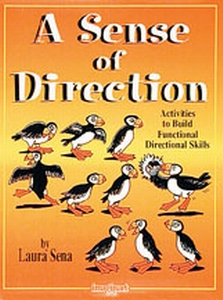A Sense of Direction

This state-of-the-art program addresses directional confusion by targeting concepts such as left/right, forward/backward, and up/down. Children with learning or language disabilities learn body awareness and directional concepts relative first to themselves, then to the environment, and finally to others.
More than 40 lessons are developmentally sequenced in four levels from simple to advanced. The book begins by teaching general body awareness, as in Alligator, where the child becomes aware of different body parts touching the floor as he moves. The self becomes a reference point in Crumple, where the blindfolded child identifies where she hears the paper crumbling around her right, left, in front, etc. The next level uses the environment as a reference point. Students follow simple maps (such as a prairie dog town), mazes, and floor grids (made by creating squares with masking tape on the floor). The last section uses others as reference points. One activity has the child look at pictures of people in various poses, identifying that person¹s left or right body parts.
You’ll especially appreciate these features: € pre- and post- tests € dozens of reproducible worksheets € background information on how directional skills develop
Building functional directional skills is one of the most important things we can do to help children ages 5 through12 years succeed in the classroom and in daily life.


